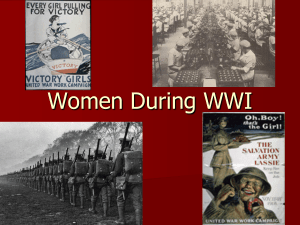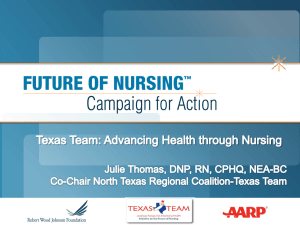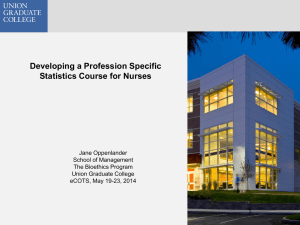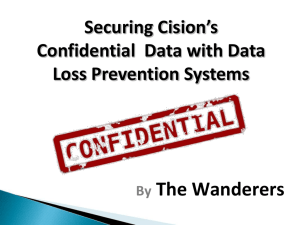Downloaded - NurseMind
advertisement
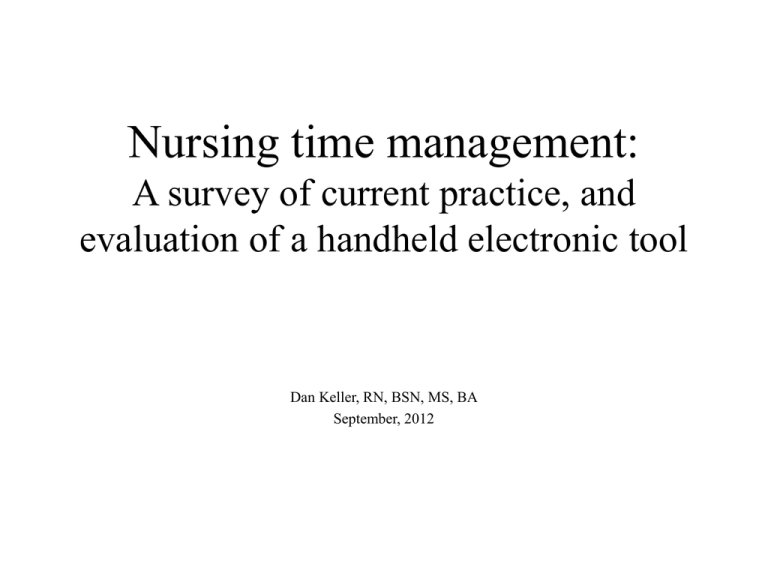
Nursing time management: A survey of current practice, and evaluation of a handheld electronic tool Dan Keller, RN, BSN, MS, BA September, 2012 PICO-Formatted Clinical Question •Among registered nurses working shifts in medical-surgical acute care hospital units... •Does the use of electronic nurse-created cognitive artifacts*... •Compared with paper nurse-created cognitive artifacts... •Achieve improved patient and nursing outcomes?** * This term was coined by Sharon McLane in her 2009 PhD dissertation, “Understanding Nurse Created Cognitive Artifacts.” The informal term is nurses' “brains”. It refers to devices (usually paper) nurses use to remember details about their patients and duties. ** The term “improved patient outcomes” is defined and measured as fewer nursing-caused adverse events such as medication errors, falls, and pressure ulcers. “Improved nursing outcomes” regards perceptions by nurses of improved quality and reduced stress in their nursing practice, and by nursing unit management as decreased overtime expense and job turnover. Review of the Literature • There is no literature to review regarding electronic time management tools for nurses because the tool discussed here is the first of its kind. • Regarding nursing time management, there is scant research. This project proposes to investigate that, too. • In accordance with principles of grounded theory, this project searches the literature enough to identify the gaps but not so much as to risk becoming biased; the theory should emerge from the data and not be forced by preconceptions. MeSH Terms for Literature Search • Health Care Quality, Access, and Evaluation [N05] – Delivery of Health Care [N05.300] • Nurse's Practice Patterns [N05.300.581] • Health Services Administration [N04] – Patient Care Management [N04.590] • Delivery of Health Care [N04.590.374] • Nurse's Practice Patterns [N04.590.688] – Organization and Administration [N04.452] • Time Management [N04.452.932] • Computers, Handheld [L01.224.230.260.550.500] • Psychological Phenomena and Processes [F02] – Psychology, Applied [F02.784] • Psychology, Industrial [F02.784.692] • Efficiency [F02.784.692.351] • Task Performance and Analysis [F02.784.692.746] • Time Management [F02.784.692.816] – Human Engineering [F02.784.412] • Data Display [F02.784.412.221] • Man-Machine Systems [F02.784.412.575] • Task Performance and Analysis [F02.784.412.846] – Time and Motion Studies [F02.784.412.846.707] – Work Simplification [F02.784.412.846.853] • Time Management [F02.784.412.923] Research Method • • • Describe the processes and methods of time management used by nurses working their shifts in acute care hospitals. Use grounded theory (Schmidt, 2009, p. 170). Write in a reflective journal on my clinical rotations. – Record ideas, thoughts, possible emerging themes and patterns, questions for follow-up, potential categories for data coding. – Done. See http://www.nursing.keller.com/#jnl • Moderate a focus group. – Formulate interview questions. – 6-8 people with a common interest (nursing) who do not know each other well – Researcher acts as facilitator. • Conduct interviews with working nurses. – Ask open-ended questions. – Note negative case examples and conflicting information. – Collect “brains”. • • Generate a theory. Develop a practice guideline. Related Population: Student Nurses • Conceived by a student nurse, this tool could prove beneficial to that population. • A logical study timeframe and group would be the students (half dozen or so) on a clinical rotation. • Working with the instructor, we could define the shifts and protocols for students to use. • Working without the instructor, we could provide a letter for participating students to provide to their instructors, explaining goals, methods, and probability of improved performance. • Reward to participants: an iTouch or a gift certificate. Interviews • 10-20 interviews • Audiotaped, transcribed, and analyzed • Sample questions: – – – – – How do you manage your time during your shifts? How do you decide what to do next? How do you make sure you don't forget to do anything? How do you decide what's important or what's urgent? If you use a paper “brain”, how often do you consult it and why? Please provide a copy. – How is your performance affected by the use of the handheld electronic tool? Sample Brain #1 Sample Brain #2 Sample Brain #3 Sample Brain #4 Courtesy of Sharon McLane, RN, PhD, MBA Sample Brain #5 Courtesy of Laurie Rosa, RN Sample Brain #6 Courtesy of Eric Holland, RN The Electronic Brain • • • • “NurseMind” To-do list with deadlines Shift-at-a-glance Tuned for nursing units (med-surg, ED, rehab, etc.) Screen Shots Strength of Study Design • Weaker than that of a systematic review -– There is little literature to review. – To date, no study like this one has been done. • Weaker than a randomized controlled double blind study – – This study cannot be double blinded. – Subjects necessarily know whether they are using an electronic or a paper "brain". • Hence, this is categorized as a cohort study. – Not the best quality of evidence. – It’s the best possible given the existing constraints. Implementation • Equip subjects with app on an Apple iPod Touch – Nurses receive the device to use during the study and keep it upon completion – Nursing units may elect to equip nurses with devices • Periodic follow up – Interviews – Questionnaires – Focus groups Evaluation How will we measure change in quality of nursing care? • Patient outcomes (“after” compared to “before”) – – – – – Falls per 1000 patient days Pressure ulcers per 1000 patient days Medication errors per 1000 patient days Patient satisfaction surveys Others to be determined • Nurses’ subjective experience – Improvements in scores reported in job satisfaction surveys – Reductions in reported stress levels • Nursing unit performance measures – Average overtime hours worked per shift – Job turnover rate Discussion (Project Summary) • • • • • • • • • This is a research project that has not yet been done. It is in the refinement and proposal stage. Some clinical rotation journaling has been done. The time management tool (an iPhone app) has been under intensive development for two years and is ready for release. Interviews and focus groups will be planned and implemented. Two beta tests have been run at two different hospitals. More beta sites are being identified. This project is expected to be conducted during 2012-2013. A theory will be proposed. A nursing practice guideline will be developed. References Armour K. (2004). PDAs in nursing. Here's why & how to use this emerging clinical tool. AWHONN Lifelines. 8(3):241-7. Brian, J., Brian, D., Hildebrandt, S., Stolworthy, Y. (2004). Software for nursing: RNs are mobilizing. In S. Strayer, P. Reynolds, & M. Ebell (Eds.), Handhelds in medicine: A practical guide for clinicians (pp. 289-318). New York: Springer. Brubaker CL, Ruthman J, Walloch JA. (2009). The usefulness of personal digital assistants (PDAs) to nursing students in the clinical setting: a pilot study. Nurs Educ Perspect. 30(6):390-2. Garrett B, Klein G. (2008). Value of wireless personal digital assistants for practice: perceptions of advanced practice nurses. J Clin Nurs. 17(16):2146-54. Keller D. (2010). Nurses Need Better Tools. Downloaded July 5, 2010 from http://www.nursing.keller.com/whatshard.html Koeniger-Donohue R. (2008). Handheld computers in nursing education: PDA pilot project. J Nurs Educ. 47(2):74-7. McLane S. (2009). Understanding Nurse Created Cognitive Artifacts: Personally-Created-Cognitive-Artifacts as External Representations of Distributed Cognition. Unpublished doctoral dissertation, University of Texas School of Health Information Sciences, Houston, TX. Personal communication. Prgomet M, Georgiou A, Westbrook JI. (2009). The impact of mobile handheld technology on hospital physicians' work practices and patient care: A systematic review. J Amer Med Informatics Assoc. 16(6):792-801. PDAs help nurses improve care and save time. Healthcare Benchmarks Qual Improv. 2002 Oct;9(10):44-6. Platt A, Reed B. (2001). Meet new pain standards with new technology. Documentation takes a leap--into the palm of your hand. Nurs Manage. 32(3):40-3. Sarasohn-Kahn J. (2010). How smartphones are changing health care for consumers and providers. California HealthCare Foundation. Downloaded April 10, 2010 from http://www.chcf.org/publications/2010/04/how-smartphones-are-changing-health-care-for-consumersand-providers Schmidt NA, Brown JM. (2009). Evidence-Based Practice for Nurses. Jones and Bartlett: Sudbury, MA. Schneider AH. (2006). Using palm-based technology in a chronic pain practice. Am J Hosp Palliat Care. 23(3):173-4. Schuerenberg BK. (2003). When Goliath can't help, David does the job. Health Data Manag. 11(2):72-4, 76, 78 passim. Potential for Publication • We hope to publish a paper regarding our results. • Amer J Nsg author guidelines: http://edmgr.ovid.com/ajn/accounts/ifauth.htm • Propose an ANCC best practice Related Topic for Publication: Nursing “Presence” • • What it is, why it’s important How can it be measured? – – – • • • • • A strategy for conscripting participants: “snowball” e.g. CraigsList Consider three different groups for whom it’s beneficial: students, new grads, expert nurses Initial pilot study (20 nurses); later, full research study Power analysis: statistically, how many nurses are needed to prove improvement? Research questions: – – – – – • How do we recognize it? We know what it feels like when we have it. But we need an objective measure. How feasible is it for nurses to use our tool/method? Do they actually use it? (questionnaire, interviews, observation, device interaction event logging on the server) Analysis: is it used during the entire shift? At what time intervals? Measure: satisfaction, counts of functions used, saves time? Reduced overtime? Compare a unit that uses it with one that doesn’t Invite UCSF faculty participants (e.g. Judy Martin-Holland) to co-author.



